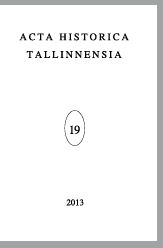EESTI LUTERI KIRIKU REAKTSIOONID USUVASTASELE KAMPAANIALE JA MAAILMAPILDI NING VÄÄRTUSTE MUUTUMISELE AASTAIL 1958–1964
RESPONSES OF THE ESTONIAN LUTHERAN CHURCH TO THE ANTI-RELIGIOUS CAMPAIGN, CHANGES IN THE WORLD VIEW AND VALUES 1958–1964
Author(s): Riho AltnurmeSubject(s): History
Published by: Teaduste Akadeemia Kirjastus
Keywords: Estonia; Estonian History; RESPONSES OF THE ESTONIAN LUTHERAN CHURCH ; ANTI-RELIGIOUS CAMPAIGN ; CHANGES IN THE WORLD ; VIEW AND VALUES ; 1958–1964
Summary/Abstract: From 1958 to 1964, the Lutheran Church in Estonia, as other churches in the Soviet Union that time had to face a strong anti-religious campaign. Even though religion was deprecated, for ideological reasons, all through the existence of the Soviet Union, the intensity of the campaign peaked during the Khrushchev years. It could be claimed that a decisive blow to the social status of the churches was struck in the 1960s. Admittedly, the same period was a time of active secularisation in free Western societies as well, but this was a voluntary trend, driven by the thought schools and changing behaviour patterns of the era. This article discusses the responses of Lutheran clergy in Estonia of that time to the surrounding social processes, particularly to the anti-church campaign and the associated attacks against persons, as well as the changes in general thought patterns, which affected public mentality. Documents in the archives of the Consistory of the Lutheran Church were used as the primary sources. From the research, Archbishop Jaan Kiivit sen. (1906–1971, Archbishop 1949–1967) generally emerges as a balancing influence between defiant clergy members and state power. The Archbishop tried to control the activities of the church, making sure that expressions of protest, if any, would move between himself and the commissioner for religious affairs, as required by the relevant regulations. In that, he was not particularly active. Speaking at various meetings of clergy members, he communicated a message of difficult times, which are not insurmountable and have to be survived with God’s help. He could draw on good examples from the history of the Christian church: early Christianity, the period after the Great Northern War in Estonia, the Moravian church movement. Local theologians, in their discussions, offered solutions trying to interpret the situation of the church on the basis of modern thought schools. For them, the development of science and technology in the 1960s was not something directly in opposition with the ideas of the church. The church was not to deny its own identity admitting the conflict of science and religion but, rather, had to start proclaiming the Christian message in new ways. The external downfall offered a chance for internal cleansing. Some theologians recognised the anti-church effect of modern thought schools and the growing fear of being associated with a church, caused by anti-religious attacks. However, they also saw two potential benefits of the anti-church propaganda: it was helping the church to see its own shortcomings and it drew public attention to the existence of the church as such, which would otherwise have been kept silent in public. Alongside these thoughts, there was also resignation under particularly strong anti-religious attacks, an understanding that any resistance could cause even fiercer assaults.
Journal: Acta Historica Tallinnensia
- Issue Year: 2013
- Issue No: 19
- Page Range: 089-114
- Page Count: 26
- Language: Estonian

